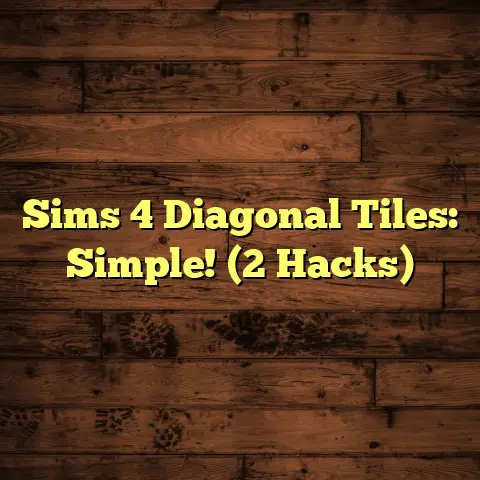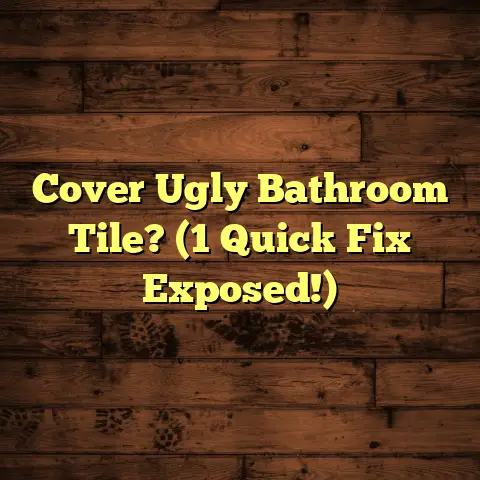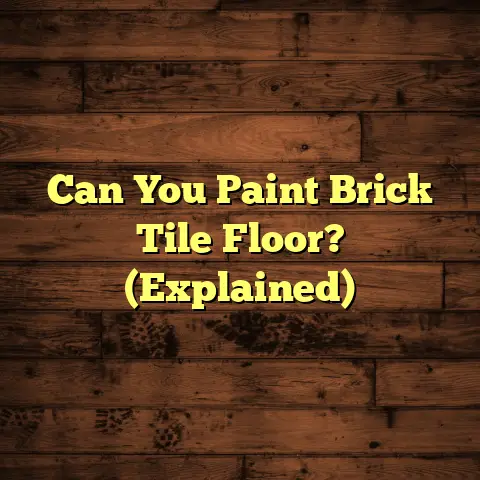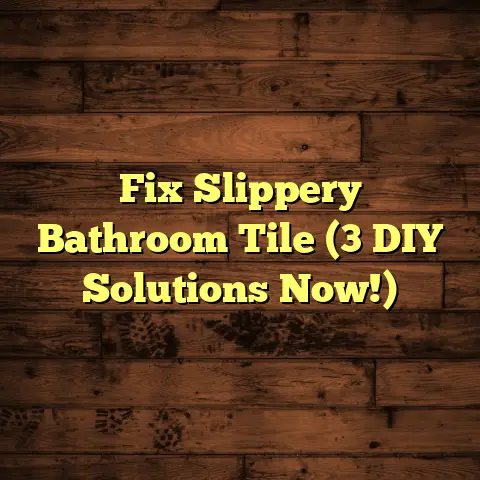Dog Slipping On Hardwood Floors? (1 Fix, Before Wipeout!)
I’m Mike, a flooring contractor with over 15 years of experience, and let me tell you, I’ve seen it all.
From flooded basements to DIY disasters, I’ve tackled every flooring woe imaginable.
But one issue keeps popping up, especially here in the Pacific Northwest, where beautiful hardwood floors are practically a rite of passage: dogs slipping and sliding!
Think about it – gorgeous, gleaming hardwood, constant rain tracked inside, and a furry friend trying to navigate it all.
It’s a recipe for disaster!
Hardwood floors are incredibly popular, adding warmth and elegance to any home. But for our four-legged companions, they can quickly turn into an ice rink.
Especially for those short-legged breeds like Dachshunds or Bulldogs, or our sweet senior pups who aren’t as steady as they used to be.
Trust me, a slipping dog isn’t just comical; it can lead to serious injuries.
In this article, I’m going to share my go-to fix for this common problem, a simple yet effective solution that will keep your furry friend safe and secure.
Section 1: Understanding the Problem
So, what exactly makes hardwood floors so treacherous for dogs?
Well, it all boils down to the surface.
Hardwood is smooth, and the finish applied to protect it only adds to the slipperiness.
Think of it like trying to run on ice with socks on – not a great combination!
Unlike carpet or rugs, hardwood offers very little traction for a dog’s paws.
Those tiny nails, designed for digging and gripping natural surfaces, just can’t get a good hold on the slick, polished wood.
Certain breeds are definitely more prone to slipping than others.
Dachshunds, with their long bodies and short legs, struggle to maintain balance on slick surfaces.
Bulldogs, with their stocky builds and low center of gravity, can also have a tough time.
And of course, older dogs, with weakened muscles and decreased mobility, are at the highest risk.
I’ve seen firsthand the impact of slippery floors on these dogs.
According to a recent study by the American Veterinary Medical Association (AVMA), falls are a leading cause of injury in senior dogs, and slippery floors are often a contributing factor.
I’ve seen everything from minor strains to more serious fractures resulting from falls on hardwood floors.
It’s heartbreaking to witness, and completely preventable.
Section 2: The Risks of Slipping
Slipping and sliding on hardwood floors isn’t just embarrassing for your dog; it can lead to a range of injuries.
Strains and sprains are common, especially in the legs and back. Imagine constantly overextending your muscles trying to regain your footing – it’s exhausting and painful!
More serious injuries, like fractures and dislocations, can occur if a dog falls awkwardly or with enough force.
These injuries often require veterinary care, including medication, physical therapy, or even surgery.
Beyond the physical risks, there’s also a significant psychological impact.
A dog who constantly slips and slides on hardwood floors can develop a fear of walking or running.
They might become hesitant to move around the house, sticking to carpeted areas or avoiding certain rooms altogether.
This decreased mobility can lead to weight gain, muscle loss, and a general decline in their quality of life.
I’ve seen dogs become withdrawn and anxious, simply because they’re afraid of falling.
It’s crucial to address the slipping issue not only for their physical well-being but also for their mental and emotional health.
Section 3: Identifying the Signs of Slipping Issues
How can you tell if your dog is having trouble on your hardwood floors?
Here are a few telltale signs to watch out for:
- Hesitation to walk: Does your dog seem reluctant to walk on the hardwood? Do they take small, tentative steps?
- Slipping or sliding: This one’s obvious, but pay attention to how often your dog loses their footing.
- Splayed legs: Are your dog’s legs splaying out to the sides as they try to walk? This is a sign they’re struggling to maintain balance.
- Changes in gait: Have you noticed any changes in your dog’s walking pattern? Are they limping or favoring one leg?
- Reluctance to play: Does your dog avoid playing on the hardwood floors? Do they seem less energetic than usual?
- Nail marks: Check your hardwood floors for scratches from your dog’s nails as they try to grip the surface.
- Increased anxiety: Is your dog panting, pacing, or showing other signs of anxiety when on the hardwood?
To assess your dog’s comfort level, observe them in different situations.
Watch them as they walk, run, play, and try to navigate corners.
Pay attention to their body language and how they interact with the floor.
If you notice any of these signs, it’s time to take action.
Section 4: The Solution – Implementing the Fix
Alright, let’s get to the good stuff!
My go-to solution for dogs slipping on hardwood floors is simple, affordable, and highly effective: non-slip rugs or mats.
These aren’t just any rugs; we’re talking about rugs specifically designed to provide traction and stability for your furry friend.
The key is to choose rugs with a non-slip backing, preferably made of rubber or a similar material.
This will prevent the rug from sliding around on the hardwood floor, creating a stable surface for your dog to walk on.
I recommend rugs with a low pile or a textured surface.
Avoid thick, plush rugs, as these can actually be more difficult for dogs to navigate.
The texture provides extra grip for their paws, helping them maintain their balance.
Adhesive anti-slip mats are another great option, especially for smaller areas like entryways or hallways.
These mats stick directly to the hardwood floor, providing a secure and stable surface.
When selecting rugs, consider your home’s decor.
You want something that’s both functional and aesthetically pleasing.
Luckily, there are tons of stylish non-slip rugs available in a variety of colors, patterns, and sizes.
Choose rugs that complement your existing decor and create a warm and inviting atmosphere.
Remember, the goal is to create a safe and comfortable environment for your dog without sacrificing the beauty of your home.
Section 5: Step-by-Step Guide to Implementing the Fix
Okay, let’s get practical.
Here’s a step-by-step guide to properly placing and securing non-slip rugs or mats:
Step 1: Measure the areas where slipping occurs most frequently.
Use a measuring tape to determine the size of the areas where your dog is having the most trouble.
This will help you choose the right size rugs or mats to cover those areas effectively.
Step 2: Choose the right size and type of rugs based on the measurements and dog’s needs.
Consider the size of your dog and the amount of space they need to move around comfortably.
Select rugs that are large enough to provide ample traction but not so large that they become a tripping hazard.
For entryways, hallways, and high-traffic areas, I recommend using larger rugs that cover a significant portion of the floor.
For smaller areas, like in front of the water bowl or near their bed, smaller mats will suffice.
Step 3: Clean the hardwood surface to ensure proper adhesion or grip.
Before placing the rugs or mats, thoroughly clean the hardwood floor to remove any dirt, dust, or debris.
This will ensure proper adhesion and prevent the rugs from sliding around.
I recommend using a hardwood floor cleaner that’s safe for pets.
Avoid using harsh chemicals or abrasive cleaners, as these can damage the floor and irritate your dog’s paws.
Step 4: Position the rugs in strategic locations, like entryways, high-traffic areas, and spaces where the dog frequently plays.
Think about where your dog spends most of their time and where they’re most likely to slip.
Place rugs in those areas to provide maximum traction and support.
Pay special attention to entryways, as these are often the first places where dogs encounter hardwood floors.
Place a rug just inside the door to give them a secure place to step.
High-traffic areas, like hallways and living rooms, should also be covered with rugs.
And don’t forget about the areas where your dog likes to play.
Place rugs in those spaces to encourage them to be active and playful without fear of slipping.
Step 5: Regularly check the positioning and condition of the rugs to maintain effectiveness.
Over time, rugs can shift and slide, especially in high-traffic areas.
Regularly check the positioning of your rugs and mats to ensure they’re still providing adequate coverage.
If you notice any slipping or sliding, reposition the rugs or mats as needed.
Also, inspect the rugs for wear and tear.
If they’re starting to fray or lose their grip, it’s time to replace them.
Section 6: Maintenance and Care for the Fix
To keep your non-slip rugs and mats clean and effective, regular maintenance is essential.
Vacuum the rugs regularly to remove dirt, dust, and pet hair.
This will help prevent the buildup of allergens and keep the rugs looking their best.
For spot cleaning, use a mild detergent and a damp cloth.
Avoid using harsh chemicals or abrasive cleaners, as these can damage the rugs.
For deeper cleaning, you can rent a carpet cleaner or hire a professional cleaning service.
Be sure to choose a cleaning solution that’s safe for pets.
Regularly inspect the rugs for wear and tear.
Check for frayed edges, loose threads, and damage to the non-slip backing.
If you notice any significant damage, it’s time to replace the rugs.
To protect the hardwood floor beneath the rugs, I recommend using rug pads.
Rug pads provide an extra layer of cushioning and prevent the rugs from scratching or damaging the floor.
They also help to keep the rugs in place and prevent them from sliding around.
Lift the rugs periodically to allow the hardwood floor to breathe.
This will help prevent the buildup of moisture and mold.
Section 7: Alternative Solutions (Brief Overview)
While non-slip rugs and mats are my preferred solution, there are a few other options you can consider:
- Dog booties designed for traction: These little shoes slip onto your dog’s paws and provide extra grip.
- Paw wax that can be applied to a dog’s paws to enhance grip: This wax creates a sticky surface on your dog’s paws, helping them grip the floor.
- Professional treatments for hardwood floors that can increase traction: Some companies offer treatments that can be applied to your hardwood floors to make them less slippery.
These alternative solutions can be helpful in certain situations, but they’re not always as effective as non-slip rugs and mats.
Booties can be uncomfortable for some dogs, and paw wax needs to be reapplied frequently.
Professional treatments can be expensive and may not be suitable for all hardwood floors.
Conclusion
Addressing the issue of dogs slipping on hardwood floors is crucial for their safety and well-being.
By taking proactive steps, like implementing the fix I’ve discussed, you can prevent potential injuries and help your dog feel more secure in their home environment.
Non-slip rugs and mats are a simple, affordable, and effective solution that can make a world of difference for your furry friend.
So, don’t wait until your dog gets injured to take action.
Implement this fix today and give your dog the gift of safety and confidence.
Call to Action
I’d love to hear about your experiences with hardwood floors and your dogs.
Have you struggled with slipping issues?
What solutions have you tried?
Share your stories and tips in the comments below!
And if you’re ready to try out the fix I’ve suggested, I encourage you to give it a try.
I’m confident that you’ll see a significant improvement in your dog’s comfort and safety.
Remember, a happy dog is a safe dog!





